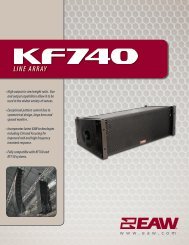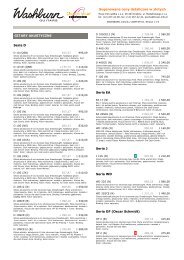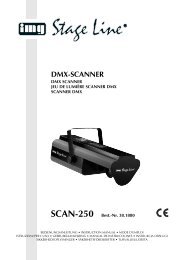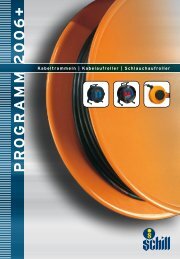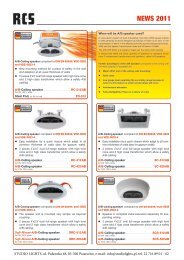Part - Studio Lights
Part - Studio Lights
Part - Studio Lights
You also want an ePaper? Increase the reach of your titles
YUMPU automatically turns print PDFs into web optimized ePapers that Google loves.
KNOW-HOW ›PRO-SOUND‹ TECHNOLOGY<br />
PA-Systems<br />
Basically, there are two kinds of PA systems: the passive and<br />
the active version.<br />
1. The passive system:<br />
This is the simplest way of frequency segmentation. The<br />
full range signal is sent into the power amplifier and then<br />
arrives at the separating filter, which is located between<br />
the power amplifier and the individual loudspeakers and<br />
consists of spools, condensers and resistors. Passive<br />
separating filters are often directly implemented inside a<br />
loudspeaker. The advantages to active systems are small<br />
technical effort and compactness. However, a big disadvantage<br />
arises from the fact that the frequency segmentation<br />
is carried out behind the power amplifier, and therefore<br />
the full output power runs through the separating filter.<br />
Consequently, large analogue components are necessary,<br />
which heat up very strongly, caused by the energy input,<br />
so that the performance is reduced.<br />
High-pass Hochpass filter<br />
Assembling of loudspeakers<br />
If loudspeaker boxes are piled on top of each other, periodically<br />
the deletion of frequencies occurs. The offset of the speakers<br />
is equivalent to half the wavelength of the first deleted frequency<br />
(see fig. 4). It is therefore essential to install the<br />
loudspeaker cabinets flush mount.<br />
Fig. shows incorrect assembling<br />
λ<br />
2<br />
Sound pressure level (SPL – dBA)<br />
The sound pressure level is an important requirement for the<br />
planning of a room´s acoustic irradiation. The following chart<br />
(fig. 5) shows, which requirements are made to power amplifiers<br />
and loudspeakers in order to implement the project<br />
sizes realistically.<br />
λ<br />
Fig. 4<br />
Low-pass Tiefpassfilter<br />
Fig. 2<br />
2. The active system<br />
Here, in contrast to the passive version, the separating filter<br />
is located in front of the power amplifier. The following<br />
significant advantages result out of this: Smaller components<br />
(IC) are used. No heating takes place. Several features<br />
are possible such as level control, mute, phasing turner,<br />
and the cut-off-frequency can be adjusted.<br />
Line-Signal signal vom<br />
Mischpult<br />
from mixer<br />
High-pass Hochpassfilter<br />
Band-pass Bandpassfilter<br />
Highs Höhen<br />
Mids Mitten<br />
Lows Bass<br />
Decrease of the sound pressure level with<br />
distance (outdoor). A doubling always<br />
results in -6 dB based on 1 m.<br />
Fig. 5<br />
Fig. 3<br />
Low-pass Tiefpass filter<br />
Separating Weiche filter<br />
Lows Bass<br />
The rule of thumb for 3-way power segmentation is:<br />
Approx. 10% of the power are used for the tweeter,<br />
approx. 30% for the mids and approx. 60% for the<br />
woofer.<br />
The widespread opinion, that the speaker´s load rating<br />
has to be higher than the output power sent out from the<br />
amplifier, is wrong. It should be exactly vice versa in<br />
order to avoid damages to the loudspeakers. The output<br />
power of the amplifier should be a little higher than the<br />
designation of the loudspeakers (consider headroom<br />
and clipping). Furthermore, one should bear in mind that<br />
the cables from the power amplifier to the speaker ought<br />
to be as short as possible. It is therefore better to use<br />
two amp-racks for large systems.<br />
Sound control<br />
The application of various kinds of mixers not only depends<br />
on the number of channels and aux lines, but also on the<br />
sound control. The most common mixers for disco applications<br />
or live mixers mostly have a 2- or 3-band sound control<br />
for individual channels: one control for lows, mids and<br />
highs. A decrease or an increase of a certain frequency can<br />
be generated within a frequency range predefined by the<br />
manufacturer, with these controls.<br />
This kind of sound control is sufficient for DJ mixers, as<br />
mostly canned music is used.<br />
In order to equalize e.g. a (singing) microphone and, if necessary,<br />
to filter unwanted feedbacks or characteristics of the<br />
voice, regarding live acoustic irradiation, a so-called “(semi-)<br />
304



